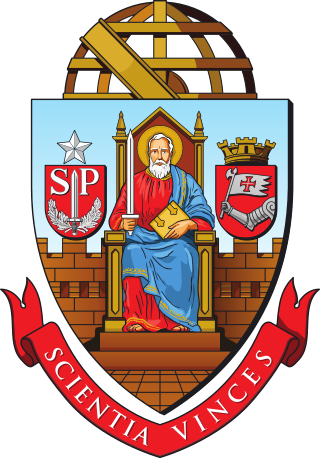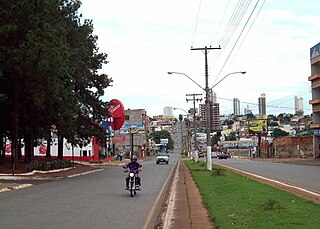
The Federal University of Minas Gerais is a federal research university located in the state of Minas Gerais. Its main and biggest campus is located in the city of Belo Horizonte, Brazil. It is one of Brazil's five largest and highest-ranked universities, being the largest federal university. It offers 79 undergraduate education programs, upon completion of their curricular schedule the student is awarded either a bachelor's degree, a licenciate degree, or a professional title, all officialized by the issue of a university diploma. It also has 90 postgraduate education programs, awarding 30 postbaccalaureate specialization degrees, 92 master's degrees, and 72 doctoral degrees, as well as 41 medical residency programs offered at UFMG's hospital facilities complexes.

The University of São Paulo is a public university in the Brazilian state of São Paulo. It is the largest Brazilian public university and one of the country's most prestigious educational institutions. USP is involved in teaching, research and university extension in all areas of knowledge, offering a broad range of courses.

The Federal University of Rio Grande do Sul is a Brazilian public federal research university based in Porto Alegre, Rio Grande do Sul. UFRGS is among the largest and highest-rated universities in Brazil, having one of the largest number of scientific publications. From 2012 to 2019, the university was elected as the best federal university of Brazil. UFRGS has over 31,000 undergraduate students, over 12,000 graduate students, and more than 2,600 faculty members. As a Brazilian public federal institution, students do not pay tuition fees to enroll in courses offered by the university.

São Paulo State University is a public university run by the state government of São Paulo, Brazil.

Rio Verde is a municipality in the Brazilian state of Goiás. It is a fast-growing center and is the largest producer of grains in the state.

Luís Fernando Verissimo is a Brazilian writer. Verissimo is the son of Brazilian writer Erico Verissimo and lived with his father in the United States during his childhood. Best known for his crônicas and texts of humor, more precisely satire of manners, published daily in several Brazilian newspapers, Verissimo is also a cartoonist, translator, and television writer, playwright and novelist. He has also been advertising and newspaper copy desk. He is also a musician, having played saxophone in a few sets. With over 60 published titles, is one of the most popular contemporary Brazilian writers.

The Federal Rural University of Rio de Janeiro is a public university located in Seropédica in the State of Rio de Janeiro, Brazil. It possesses the largest campus among Latin American universities and is known for being the first university to offer agriculture related courses in Brazil.

The Universidade Feevale (Feevale) is a Brazilian university in the city of Novo Hamburgo in the metropolitan region of Porto Alegre, Rio Grande do Sul. The selection process is through entrance exam and continuous assessment.

Centro Universitário das Faculdades Metropolitanas Unidas is a Brazilian institution of higher education located in the city of São Paulo. The university is better known by the acronym FMU, which is maintained for the sake of tradition, since it has been popularly called FMU since its founding.
Roberto Duailibi, is a Lebanese-Brazilian advertising executive originally from Zahlé.

Centro Universitário da FEI is a higher education facility in São Bernardo do Campo, Brazil, offering undergraduate degrees in engineering, business administration, and computer sciences as well as master's degrees in mechanical engineering, electrical engineering, and administration; specialization courses are also offered. It is often ranked among the best Brazilian private engineering colleges and best overall in mechanical engineering, electrical engineering, and computer science.

The School of Communications and Arts at the University of São Paulo is an institution of higher education and research in the field of Arts and Communication located in São Paulo, Brazil. It was established on June 15, 1966 as School of Cultural Communication.

Ruth Guimarães Botelho was the first Afro-Brazilian author to gain a national audience and critical attention for her novels, short stories, and poetry. A classical scholar, she translated works from French, Italian and Spanish and studied Greek and Latin, though her works reflected fables, folklore, herbal medicines and legends of Afro-Brazil. She established several cultural preservation societies, served as head of the Ministry of Culture for Municipality of Cruzeiro, São Paulo, and was a member of the São Paulo Academy of Letters.

Eco Moliterno is a Brazilian advertising executive and the Chief Creative Executive Officer of Accenture Interactive for Latin America, one of the largest and fastest growing digital agency networks according to Advertising Age. Previously, Moliterno was the executive creative director at Africa, one of the leading agencies in Brazil, as part of Grupo ABC, where he worked for 7 years.
Dudi Maia Rosa is a Brazilian artist.

The Escola Preparatória de Cadetes do Exército - EsPCEx is a coeducational one-year military school in Campinas, São Paulo, Brazil. EsPCEx started construction in 1944, but due to budget constraints, did not open until the late 1960's.

Universidade Estadual do Maranhão is a public state university in the state of Maranhão, Brazil. It was founded on March 25, 1987, and is based in São Luís. In addition to the Universidade Federal do Maranhão (UFMA), it was the second university in the state. In September 2016, part of it was dismembered for creation of a third, the newly founded Universidade Estadual da Região Tocantina do Maranhão (UEMASUL). With more than 20 thousand students, the institution has 22 campuses and 25 university centers. In the university ranking, it ranks 157th in Brazil. The university rector is Gustavo Pereira da Costa.














